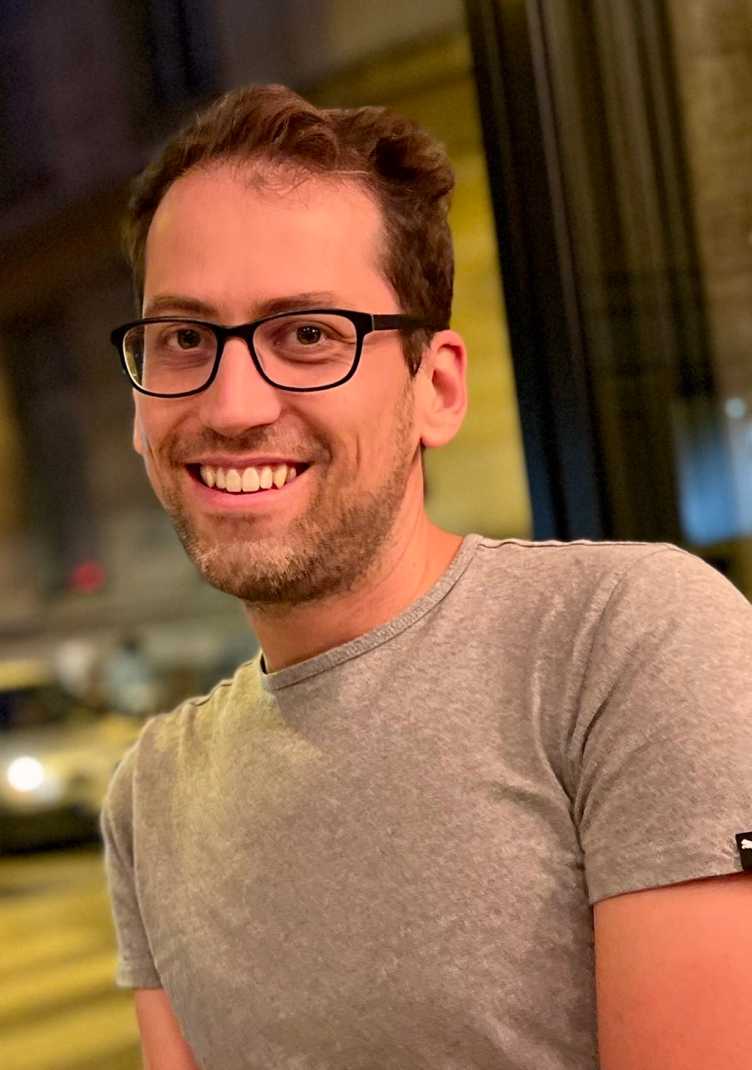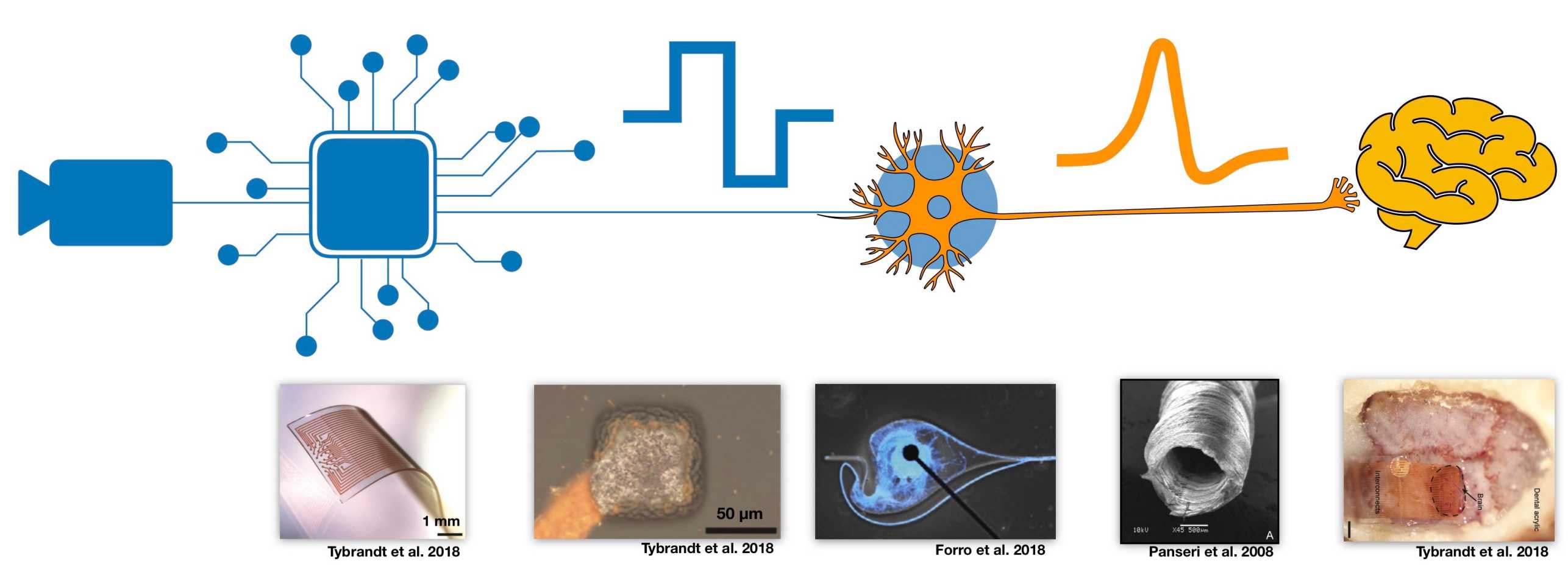Ruff, Tobias Dr.

Tobias Ruff, PhD
Postdoc, April 2020 to Feb. 2024
Inst. f. Biomedizinische Technik
Gloriastrasse 37/ 39
8092
Zürich
Switzerland
Understanding adult brain reinnervation using a biohybrid neural interface with living neurons.
Implantable biohybrid multielectrode array
Axonal damage within the adult mammalian CNS results in an irreversible loss of those connections. Attempts to regenerate and target axons back to their target location (often mm away from the origin) largely failed due to a lack axon guidance cues and the inhibitory environment in the adult CNS.

To overcome those limitations, I am interested in the development of a biohybrid platform in which neurons are cultured on a flexible implantable multichamber multielectrode array connected to an axon guiding nanofiber tube. In our biohybrid approach neurons act as small relay stations which will enable us to stimulate the adult brain synaptically.
To achieve that goal we need to understand how we can control the axonal reinnervation pattern and synapse formation in adult brain. During embryonic development receptor/ligand gradients and spontaneous patterned neural activity direct axons to their target location. In the adult brain these mechanisms are missing and prevent axonal regeneration.
Using our biohybrid approach we will explore how we can functinoally reinnervation in the adult brain.
The ultimate goal of this line of research is to restore biocompatible high-resolution sensory input to the adult brain.
Biographic summary:
Studied chemistry, biochemistry and neurobiology at the Ludwig Maximilian University Munich, Germany. Starting in 2014 doctoral thesis with Prof. Rüdiger Klein and Daniel del Torro at the Max Planck Institute of Neurobiology where we provided the first biological evidence that cortical fold formation in the mouse can be induced by modulating the balance between adhesion and repulsion of migrating neurons by manipulating FLRT1/3 levels. In parallel we characterized a new retinal ganglion cell subtype in the mouse retina. In 2020, I joined Janos Vörös lab as an HFSP funded postdoc to continue working on biohybrid neural interfaces.
Invited talks:
- 2023 Universitätsklinikum Bonn, Germany, "Engineering a biohybrid neural interface for sensory restoration"
Contributed talks:
- 2023 MRS, Boston, USA, "Engineering a biohybrid neural interface towards synaptic deep brain stimulation"
- 2023 NanoBioTech Montreux, Switzerland, "A living biohybrid neural interface towards synaptic brain stimulation"
- 2023 Artificial vision conference, Duisburg, Germany, "Engineering a biohybrid neural interface for vision restoration"
- 2023 SSSBE conference, Basel, Switzerland, "A Living biohybrid neural interface for synaptic deep brain stimulation of the visual thalamus"
- 2023 Bioelectronics Symposium, Cambridge, UK, "Engineering a biohybrid neural interface for synaptic stimulation of the visual thalamus"
- 2023 Alumni meeting, Ringberg, Germany, " Restoring vision using biohybrid neural interfaces"
- 2022 Materials Research Society meeting, Honolulu, USA, "Retinal ganglion cell reinnervation of thalamic target structures"
Poster presentations:
- 2023 Microphysiological Systems Conference, Berlin, Germany, "Engineering a microfluidic based living neural interface towards vision restoration"
- 2023 Maxwell User meeting, Zurich, Switzerland, "Engineering a biohybrid neural interface for synaptic stimulation of the visual thalamus."
- 2022 Biointerfaces Conference, Zurich, Switzerland, "Unidirectional signal transmission in PDMS microstructures to enable biohybrid interfaces"
- 2022 FENS Paris, France, "Towards stretchable hybrid neuroelectronic implants"
- 2022 MEA meeting, Tübingen, Germany, "Towards biohybrid brain stimulation using unidirectional PDMS based axon guidance structures"
- 2022 Maxwell User meeting, Zurich, Switzerland, "Towards a biohybrid neural implant"
- 2021 Gordon Research Conference, Ventura, USA, "Towards a biohybrid neuroelectronic implant"
- 2021 NanoBioTech, Montreux, Switzerland, "A biohybrid retinal ganglion cell neural interface to restore vision"
- 2021 World Laureate Forum, Shanghai, China, A bioyhbrid retinal ganglion cell neural interface to restore vision"
- 2021 Biointerfaces, Zurich, Switzerland, "Investigating adult brain reinnervation using a biohybrid retinal ganglion cell multielectrode array"
- 2021 Human Frontiers Science Program Meeting, Paris, France, Investigating adult brain reinnervation using a biohybrid retinal ganglion cell multielectrode array"
- 2016 SfN, San Diego, USA, "Characterizing a subpopulation of retinal ganglion cells"
- 2016 FENS, Coppenhagen, Denmark, "FLRTs regulate cortical migration and reveal novel mechanisms of cerebral cortex folding"
Student Projects:
If you are interested please send me a short CV including a few sentences on your motivation in joining this project. First details of the project will be discussed during the interview.
A big thank you to all students for their contributions to this project:
- Eylul Ceylan (Master Thesis, 2021)
- Margherita Razzoli (Semester project, 2021)
- Anna Beltraminelli (Master Thesis, 2021)
- Simon Steffens, Winner of the Semesterpreis for his master thesis (2021)
- Tugce Delipinar (Master Thesis, 2022)
- Tao Zhang (Master Thesis, 2022)
- Stefano Kron (Semester Project, 2022)
- Giulia Amos, Awarded the ETH Medal for her master thesis (2022)
- Leon Schönleber (Bachelor Thesis, 2023)
- Revan Kasm (Bachelor Thesis, 2023)
- Leah Mönkemöller (Semester Project, 2023)
A big thank you to all students for their contribution to associated projects:
- Juliana Strother (Thesis, 2023), Developing a stretching device to study the mechanobiology of engineered neural networks
- Lorenzo Petrella (Project, 2023), Human sensory neurons on CMOS MEAs
- Nino Wyssen (Thesis, 2023), iPSC-derived neural circuits on CMOS MEas
- Robert Jelitto (Project, 2023), Engineered biological neural networks with ultra-low neuron density on CMOS microelectrode arrays
- Robert John (Project, 2022), Single axon physiology on CMOS based microelectrode arrays
- Joël Küchler (Project, 2021), Engineering biological neural networks on high density CMOS MEAs
Public Outreach
- 2021: External advisor on the TA-SWISS study on bioelectronics. external pagehttps://www.ta-swiss.ch/en/bioelectronicscall_made
- 2022: Neural interfaces in the Journal “Horizonte” Edition 136. external pagehttps://www.horizonte-magazin.ch/2023/03/02/jedem-sein-superhirn/call_made
Publications
10. Jens Duru, Benedikt Maurer, Ciara Giles Doran, Robert Jelitto, Joël Küchler, Stephan J Ihle, Tobias Ruff, Robert John, Barbara Genocchi, János Vörös. (2023) Investigation of the input-output relationship of engineered neural networks using high-density microelectrode arrays. Biosensors and Bioelectronics, external pagehttps://doi.org/10.1016/j.bios.2023.115591call_made
9. Sophie Girardin, Stephan Johannes Ihle, Arianna Menghini, Magdalena Krubner, Leonardo Tognola, Jens Duru, Isabelle Fruh, Matthias Müller, Tobias Ruff* and János Vörös, (2023) Engineering circuits of human iPSC-derived neurons and rat primary glia. Frontiers in Neuroscience, external pagedoi.org/10.3389/fnins.2023.1103437call_made. *co-corresponding author
8. Jens Duru, Joël Küchler, Stephan J. Ihle, Csaba Forró, Aeneas Bernardi, Sophie Girardin, Julian Hengsteler, Stephen Wheeler, János Vörös, Tobias Ruff. (2022) Engineered biological neural networks on high density CMOS microelectrode arrays. external pagedoi.org/10.1101/2021.12.09.471944call_made
7. Sophie Girardin, Blandine Clément, Stephan J Ihle, Sean Weaver, Jana B Petr, José C Mateus, Jens Duru, Csaba Forró, Tobias Ruff, Isabelle Fruh, Matthias Müller, János Vörös. Topologically controlled circuits of human iPSC-derived neurons for electrophysiology recordings. external pagedoi.org/10.1101/2021.12.10.472063call_made
6. Sephan Johannes Ihle, Sophie Girardin, Thomas Felder, Tobias Ruff, Julian Hengsteler, Jens Duru, Sean Weaver, Csaba Forró, Janos Vörös. (2021) An experimental paradigm to investigate stimulation dependent activity in topologically constrained neuronal networks. Biosensors and Bioelectronics. external pagedoi:10.1016/j.bios.2021.113896call_made
5. Tobias Ruff*, Christian Peters*, Akihiro Matsumoto, Stephan Johannes Ihle, Pilar Alcalá Morales, Louise Gaitanos, Keisuke Yonehara, Daniel Del Toro, Rüdiger Klein. (2021) FLRT3 marks direction-selective retinal ganglion cells that project to the medial terminal nucleus. Frontiers in Molecular Neuroscience, *joint first authors.
4. Byron Llerena Zambrano, Aline F Renz, Tobias Ruff, Samuel Lienemann, Klas Tybrandt, János Vörös, Jaehong Lee. (2020) Soft Electronics Based on Stretchable and Conductive Nanocomposites for Biomedical Applications. Advanced Healthcare Materials, (Review).
3. Daniel del Toro*, Maria Carrasquero-Ordaz*, Amy Chu*, Tobias Ruff, Meriam Shahin, Verity A. Jackson, Matthieu Chavent, Miguel Berbeira-Santana, Goeuel Seyit-Bremer, Sara Brignani, Rainer Kaufmann, Edward Lowe, Rüdiger Klein, Elena Seiradake. (2020) Structural basis of Teneurin-Latrophilin interaction in repulsive guidance of migrating neurons. Cell, *joint first authors.
2. Daniel del Toro*, Tobias Ruff*, Erik Cederfjäll, Ana Villalba, Gönül Seyit-Bremer, Victor Borrell, Rüdiger Klein, (2017). Regulation of cerebral cortex folding by controling neuronal migration via FLRT adhesion molecules. Cell, 169(4):621-635.e16., (Highlighted in the Dynamic Neuron – Cell Press Selection; November 16, 2017). *joint first authors.
1. Elena Seiradake*, Daniel del Toro*, Daniel Nagel, Florian Cop, Ricarda Haertl, Tobias Ruff, Gönül Seyit-Bremer, Karl Harlos, Ellen Clare Border, Amparo Acker- Palmer, E. Yvonne Jones, Rüdiger Klein (2014). FLRT structure: Balancing repulsion and cell adhesion in cortical and vascular development. Neuron, 84(2):370-385. (Highlighted in the Society for Neuroscience issue; October 22nd issue, 2014). *joint first authors
